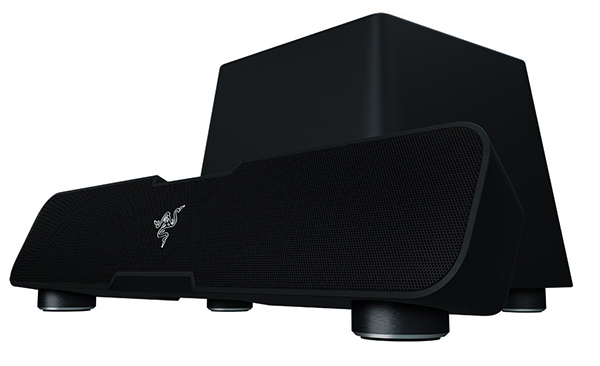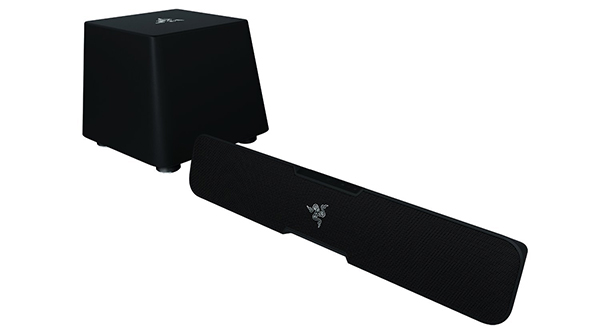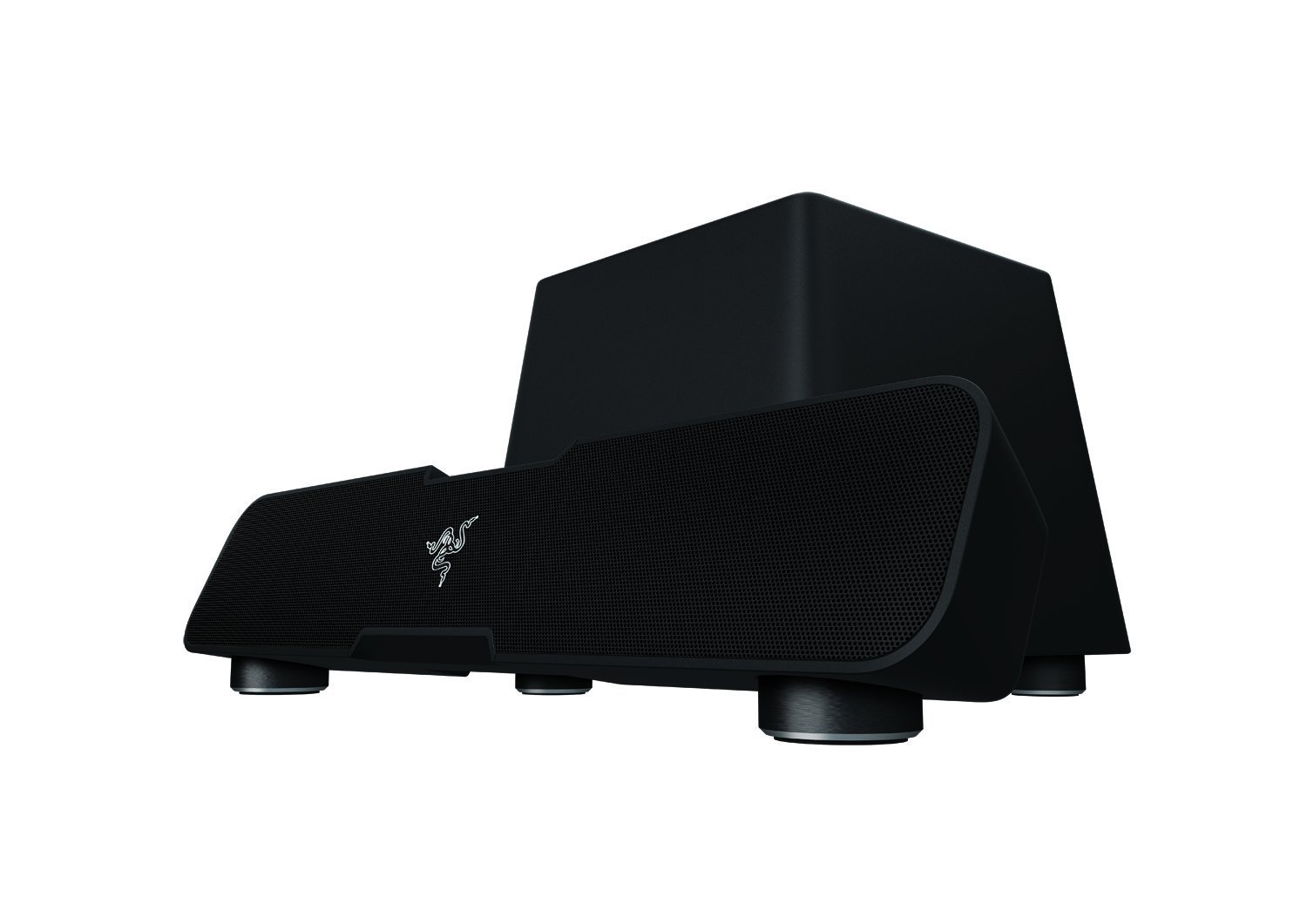Tom's Guide Verdict
Razer’s Leviathan soundbar improves the gaming experience, and it’s big, bassy sound may please music and movie lovers, too.
Pros
- +
Affordable
- +
Big bass in a small package
- +
Clear dialogue.
Cons
- -
No remote or mobile app
- -
Lacks crisp treble tones
- -
Not well suited to living room viewing.
Why you can trust Tom's Guide
Today’s video games sound as amazing as they look, but you may not have noticed if you’re using just your computer’s or TV’s speakers. Gaming hardware company Razer is here to expand your horizon: The $200 Leviathan soundbar broadens the aural experience of gameplay, and can also improve sound when you're watching movies and listening to music. It’s best up close, though: It sounded great when I paired it with a computer monitor, but the living room experience needs work.
Design
At about 20 inches long, the Leviathan is small for a TV soundbar, but it fit nicely on a desk in front of my 24-inch computer monitor (for comparison, Yamaha’s YAS-203 is 35 inches long). The black perforated grill on the front prominently features Razer’s logo in the middle and is transparent enough to show off the two 2.5-inch drivers and two 0.74-inch tweeters inside that produce the sound.

The small (approximately 10 x 8 x 8-inch) black subwoofer requires a wired connection, and that wire also provides the power to the sub.
On top, the Leviathan features a large power button. You’ll find the other controls on the top edge of the back side. In addition to controlling the volume, you can choose your input — optical digital audio, 3.5-mm analog or Bluetooth. You can also select among three sound modes (movie, game or music) and decide whether to engage the virtual surround sound feature, which takes a stereo signal and emulates a 5.1 setup. You can tell which mode you’re in based on icons to the right of the power button on the top.
Unfortunately, the Leviathan has no volume level indicator. The soundbar also lacks a remote, which hampers its use in the living room from 10 feet away. And unlike many soundbars, Razer hasn’t developed a control app, either. The only way to change the volume or input is from the soundbar itself — a real inconvenience when you’re on the couch.
Setup and Use
I connected the Leviathan to my computer monitor via the digital optical cable and used the same type of connection when trying it in the living room with a Panasonic TC-P55ST60 HDTV.

The Leviathan includes NFC to connect to Android devices with a touch. It also connected via Bluetooth to an iPhone without a problem. The soundbar supports aptX, the Bluetooth sound technology that improves the fidelity of streamed music.
MORE: Best Soundbars
Once you’ve connected it, the Leviathan offers little additional adjustments you can make for the sound quality. There are no bass or treble levels. You can physically move the subwoofer to find the best bass levels relative to where you are sitting, but the 80-inch wire limits the extent to which you can do that.

You can adjust the feet of the Leviathan to better direct the sound toward you based on how you are using it. For example, if you’re placing it in front of your monitor and you’re sitting close, using the 18-degree setting opens up the sound better than the 0-degree setting that's recommended for when you’re watching farther away.
Audio Performance
Despite its small stature, the Leviathan produces big sound. If you’re a fan of surround sound and low-end effects, you’ll find plenty to like. With 30 watts of power, Razer’s soundbar produces enough volume to fill a large room, but I found it sounded best when I was close up — like sitting in front of my computer playing games. In the living room, the bass tended to dominate the mix, and there’s no way to adjust the level.

While I was playing Call of Duty 4: Modern Warfare on a Mac, the Leviathan helped to make the experience more immersive when compared with standard computer speakers. The virtual surround sound made helicopters feel as if they were swirling around my head, and the booming subwoofer added a tactile element to the experience.
The subwoofer also added resonance to dialogue. Cate Blanchett’s exposition at the beginning of The Fellowship of the Ring came across with the intended depth and gravitas.

But there is such a thing as too much bass. During a chase scene in the Dark Knight, the low-end effects overmatched the dialogue. In the club scene during John Wick, the throbbing bass overwhelmed the other effects in the scene.
When listening to music, I liked the wide field of sound that the Leviathan produced, especially compared with the Harman Kardon SoundSticks I use at my desk. But the lack of crisp detail in treble tones meant Joshua Bell’s bright violin solos lacked punch and the horns in Mark Ronson’s "Uptown Funk” also fell flat.
Bottom Line
Razer’s onto something with a soundbar aimed at gamers — the virtual surround sound and booming bass improved the gaming experience. And few soundbars at this price also come with a subwoofer; by comparison, JBL’s $200 SB100 only includes the main soundbar. In a living room or other situation where you’ll be far from the TV, the Leviathan lacks the adjustments that you need to get the best sound and the remote to control the volume. For more flexibility, consider Yamaha’s YAS-203 or Sony’s HT-CT370. But if you love bass and only plan to use the Leviathan at close range, it’s a good match.

Michael Gowan is a freelance technology journalist covering soundbars, TVs, and wireless speakers of all kinds of shapes and sizes for Tom’s Guide. He has written hundreds of product reviews, focusing on sound quality and value to help shoppers make informed buying decisions. Micheal has written about music and consumer technology for more than 25 years. His work has appeared in publications including CNN, Wired, Men’s Journal, PC World and Macworld. When Michael’s not reviewing speakers, he’s probably listening to one anyway.

